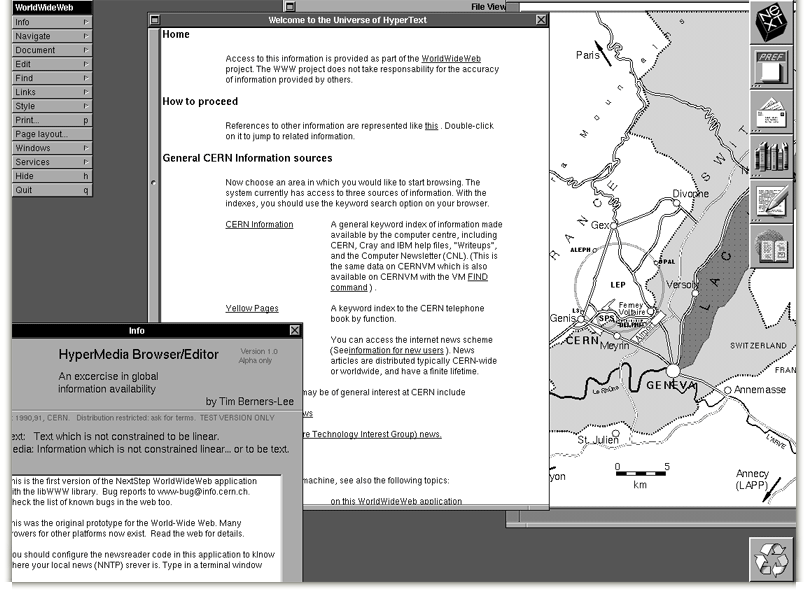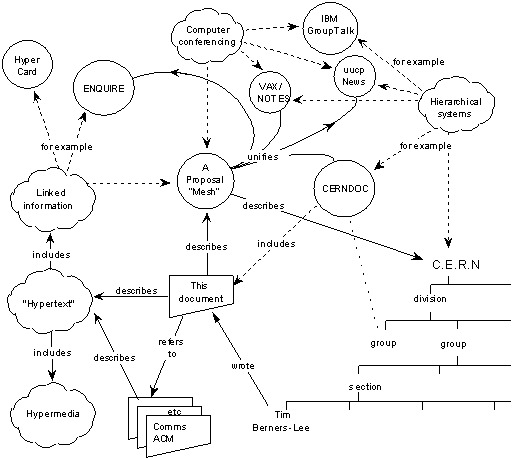20 years with the World Wide Web
Earlier this year we passed the twenty year anniversary of the world wide web; on of the most prolific inventions of our contemporary time. From this milestone a historical line can be drawn as recent iterations of the web are disseminated to a wider array of users and new uses adapts the web as a platform. Not only is the web gaining larger audiences, it is also changing various platforms until recently not being thought of as web. The last five years we have seen the renaissance of web technologies with the triforce of Javascript, HTML and CSS. We must not forget that the web has been of paramount importance in the diffusion of the Internet and is still expanding and even if its death has been prophesied.
The first days
 First, just to clear the air, the web and the Internet are two separate technologies. While we are celebrating the twentieth anniversary of the web we need to know that the Internet on which the web is working is much older. Protocols you are using daily while doing things as sending e-mails, transferring files over FTP and playing computer games online are also preceding the web with years, so why is the celebration of web such a special thing?
First, just to clear the air, the web and the Internet are two separate technologies. While we are celebrating the twentieth anniversary of the web we need to know that the Internet on which the web is working is much older. Protocols you are using daily while doing things as sending e-mails, transferring files over FTP and playing computer games online are also preceding the web with years, so why is the celebration of web such a special thing?
The world wide web was introduced in the beginning of the 90s built on the ideas of hypertext (that had already been around for decades). With the creation of a markup language, HTML, and a transferring protocol for acquiring such sites, HTTP, the web was born. Working a the European Organization for Nuclear Research, the father of the web – Tim Berners-Lee conceptualised a system where digital resources could be exchanged platform independent. On his Next computer he wrote the technology.
 At that time one could not imagine the success and widespread the technology would go through the next twenty years.
At that time one could not imagine the success and widespread the technology would go through the next twenty years.
In the eighties and nineties other structural changes helped make the web into what it is today. In the late seventies and the eighties personal computers had entered the consumer market, and as its cost grew lower and more units were sold the general importance of computing grew. Before the web, and also before the personal computers, Internet and computing was a professional realm in companies and universities, but with Internet Service Providers homes were included into the global network. The market for internet access grew as home computing became popular, and until recently, here in Norway, it was a political goal to spread computers to the homes, and home computing was partly tax-exempted. The UN and the World Bank still use percentages of home with Internet access as a measure of countries, and lacking IT literacy is spoken of as it was analphabetism.
Before the web through the Internet was possible, an abundance of open and proprietary standards, several programs with different usage and no central hub as the computer browser provides today the Internet lacked any application so ubiquitous as the web would become. E-mail servers could communicate in SMTP and POP3, but there was a lack of an open gateway where all services could be found (this will take more than twenty years, and browsers today are not totally compatible, but it is a great abstraction from when little and big endian was a problem for network communication, or from the proprietary standards of IE6.)
The web is cool and much have happened, but what I find especially amusing is the recent and ongoing development. Just think about it. The last five years more and more applications are encompassed into the web. Long before gmail and even earlier than hotmail most people downloaded their e-mail to their local computers using the POP3 standard, today it’s all online, or at least you can synchronise your mail-boxes with IMAP. Another example is the expansion of content services oriented around the web. Music, movies, pictures and friends are now living in the cloud and the cloud-access-points (desktops, laptops, mobile phones, TV-sets, tablets, information screens etc) are much more flexible than just a couple of years ago. Where did you go to access the Internet in 1995, or 2000? Now you probably have a portal close by, but ten years ago that portal was in a home-office. When did you get your first laptop? Smartphone? Wireless router? When did you sign up for Flick, Picasa, Gmail, Facebook, Twitter?
The recent technological development has largely been accredited AJAX and the rebirth of Javascript. With new Javascript engines such as Chromes V8 modern browsers are able to run Javascripts more than 100 times faster than earlier, also more effective distribution of workload onto the GPU and new standards in HTML and CSS has changed the web drastically. The web originally was a stateless experience, you asked you got served, but in-between you had a load-time unbelievable for today’s netizens. Now applications are downloaded (and with all the libraries included and assets these can be massive), but when first running locally they acquire data asynchronously. The application are now sending and receiving data without loading the whole site, they have been doing it for years, but now it starts to change the experience of the web.
Yesterday, I was looking into some of the technological changes in the web, and I tested some of the relatively new features of the web. With new iterations the web-browsers a better control of visual elements are implemented through CSS3. Box shadow, round edges, transparency and other features earlier emulated with images, smoke and mirrors are now included in the model. Here is a little demonstration of some features at lovholm.net/projects. Another demonstration which only works with newer web-kit browsers (Safari, Chrome) is showing reflections and animations through CSS3 (Click on the image).
Not only the visual aspects are changing, the HTML 5 package introduce a new and more semantic model for how to label content in HTML, this again leads to the idea where the Internet is made up of smaller parts than documents. In his book Weaving the Web, Tim Berners-Lee introduces the idea of the web of data. I like to think of it as being able to query the web, not only locally running databases. You can now have a lot of fun using YQL to query Yahoo’s interpretation of the web , or you can find the facts from Wikipedia using their service DBPedia.
Here is presentation summarising some of the open data achievements. (Do also watch the first presentation TBL on the next web)
The article picture is made by Anna Lena Schiller, licences under Creative Commons and made available on Flickr.